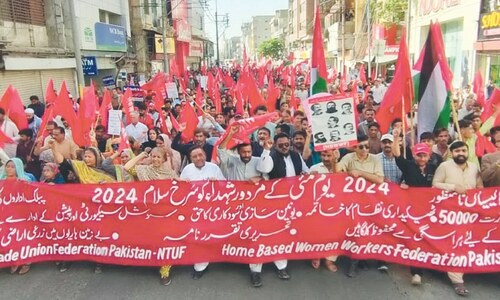KARACHI: Pakistan is the heartland of Sufi traditions across the Muslim world. This was stated by noted author and anthropologist Prof Dr Jurgen Wasim Frembgen while giving an account of the rituals and symbolism associated with Sufi saint Lal Shahbaz Qalandar’s urs at the launch of his book Charisma of the Qalandar at the German consulate on Thursday evening.
In an effort to find reasons for the popularity of Lal Shahbaz Qalandar, Dr Frembgen said he was not only venerated by Muslims but also by Hindus because the saint celebrated ‘togetherness’. Other Sufis too sought the same goal, such as Baba Farid who once said ‘don’t give me scissors, give me a needle for I don’t cut, I mend’. Talking of other Sufis from the same region made the author iterate that Pakistan was the heartland of Sufi traditions across the Muslim world, where Sufism was celebrated with ‘ecstatic religiosity’.
Dr Frembgen, with the help of a series of images, expanded on the figurative and nonfigurative representation of Lal Shahbaz. He tried to show the prepatory rituals involved in the pilgrimage to Sehwan Sharif. He said he had a collection of 250 photos taken between 2003 and 2014 and brought into focus the musician the late Nazir Ali (who had worked with the likes of Noorjehan) and his sons showing how wide the Qalandar’s popularity had become as people from the film industry (Noorjehan, Reshma, Nasibolaal, etc) were his followers as well.
Charisma of the Qalandar launched
Dr Frembgen, emphasising the saint’s popularity, spoke on the significance of the colour red which could be seen on public transport buses and rickshaws. He argued that the colour had rich symbolism, and in South Asia was considered the colour of kinship. It also signified vibrant religiosity.
He then shifted his presentation to the importance of the dhamal calling it a dance of rapture and ecstasy, which connected the Qalandar’s followers to superior forces. There were different kinesthetic styles of dance. He showed a variety of posters as part of the preparation for the urs and pointed out there were 25 types of posters, one of which depicted the image of the flying Qalandar. He said the world we lived in looked for a rational approach to things, whereas the myths linked to Sufism had humanitarian values embedded in them.
Discussing the nonfigurative depiction of the saint, Dr Frembgen showed folk paintings as Nazir Ali’s sons in Lahore’s Moon Market readied themselves for the pilgrimage. He also drew attention of the audience towards the advertisements for the urs and the symbolism related to objects such as the kishti (boat) — one account suggests that the saint came to this part of the world on a boat — and a royal falcon.
In the last part of his presentation, Dr Frembgen touched on the calligraphic representation of the saint in everyday life.
Earlier, the caretaker of the Lal Shahbaz Qalandar’s shrine, Dr Mehdi Raza Shah Sabzwari, briefly shed light on the history of the saint. He said he was born in Marwand, Persia and acquired education for 21 years in the disciplines of philosophy and religion from different educational centres in the world, including from An Najaf University in Iraq, before eventually settling in Sehwan Sharif.
Managing Director of the Oxford University Press Ameena Saiyid introduced the author. She said he had been working and researching in Pakistan since 1981.
German Consul-General Dr Tilo Klinner welcomed the guests.
After the speeches, folk singer Tufail Sanjrani, joined by dhamal performers, entertained the audience. He began his act by singing Daman lagian and followed it up with the famous numbers Sham-i-Qalandar, Yaar Daadi culminating in Dam Mast Qalandar.
Published in Dawn, November 14th, 2014















































Dear visitor, the comments section is undergoing an overhaul and will return soon.